




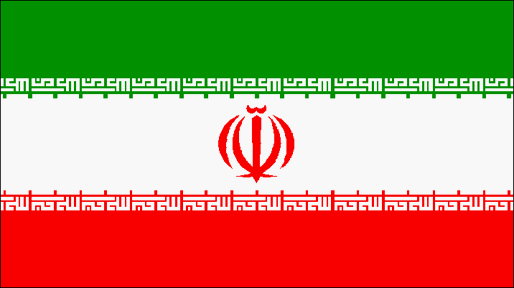
The University of Isfahan, with over 50 years of experience, is one of the leading higher educational institutes in Iran. The university embraces seven faculties with thirty departments as well as an evening school. The University of Isfahan has a unique location at the foot of the Kuh Sofeh (Sofeh mountain, 32°35'00"N 51°38'00"E) with an area of 4.5 million square meters. Over 1000 graduate students and 10,000 under-graduate students are trained in various fields of Science, Engineering, Human Science, Economics, Linguistics, Educational Science and Sport Science.
A facility associated with the Nuclear Technology/Research Center was
reportedly opened in 1984, reportedly at a location about four kilometers outside the city and between the villages of Shahrida and Fulashans. The NIMA GEOnet Names Server (GNS) has no record of either populated place, nor of phonetically similar place names. The closest matches in the area appear to be:
Fudan FRM 32°36'31"N 51°45'07"E
Fazadan FRM 32°36'00"N 51°45'00"E
Fizadan PPL 32°35'55"N 51°45'31"E
Shahrestan PPL 32°37'52"N 51°43'08"E
Shahzadeh Ebrahim SHRN 32°32'18"N 51°50'22"E
Facilities includes a Miniaturized Neutron Source Reactor [MNSR] research reactor of Chinese origin with a capacity of 27 kilowatt thermal (kWt). China and Iran signed a nuclear cooperation agreement on 21 January 1990 that reportedly included the construction of a 27 MW plutonium production reactor at Isfahan. In September 1991 American satellite imagery reportedly detected initial construction activities. The open literature is rather confused as to whether the facility in question was a new 27 MW reactor, or the 27 KW miniature neutron source. Preparatory steps were taken in the mid-1990s to bring the reactor on line, although the reactor remained incomplete as of 1997. A Chinese-supplied heavy-water, zero-power research reactor is also located at the Center. Other extensive construction activity is in progress at the center, although there contradictory reports as to whether the new buildings are designed for nuclear weapons technologies.
Construction at the site is said to include a hexafluoride plant being built with Chinese assistance. Other reports suggest that this facility may be located at the Rudan Nuclear Research Center in Fasa. Indications of the existence of this facility [wherever it may be located] include Russian press reports of a shipment of uranium hexafluoride gas from China to Iran in late 1994, as well as purchases of hydrogen fluoride from Germany and attempts to buy fluorification equipment from Britain.
Esfahan is also reportedly the site of Iran’s largest missile assembly and production plant. This ballistic missile production facility, built with North Korean assistance, is capable of producing liquid propellants and missile structural components. According to reports published in Russia, apparently based on information developed by the Russian Federal Security Service, Esfahan is involved in the production of Scud-B and Scud-C surface-to-surface missiles by assembling components bought in North Korea and China. According to the 1995 Jane's Intelligence Review - Special Report No. 6 on Iran's weapons, North Korea helped build a "Scud Mod B" (320 km/1000 kg) assembly plant in Iran in 1988, but the plant apparently never manufactured any missiles. North Korea aided Iran in converting a missile maintenance facility into an assembly plant for the Scud Mod Cs. Other activities at this facility are reported to include R&D on unguided missiles and production of missile frames.
Esfahan is said to be one of Iran's major chemical weapons facilities, along with the facilities located at Damghan [the primary production facility], Parchin and Qazvin. Iran continues to upgrade and expand its chemical warfare production infrastructure and munitions arsenal, which includes blister, blood, choking agents, and nerve agents.
The Esfahan area is a major center for Iran's advanced defense industry, with plants for munition productions, tank overhaul, and helicopter and fixed wing aircraft maintenance. The main operational facilities for the army's aviation units are located at Esfahan, presumably at Khatamin Air Base northeast of the city.
As of 05 July 2000 18 May 1990 and 01 June 1996 Russian 2-meter resolution KVR-1000 images were available via the SPIN-2 service on TerraServer. This pair of images, which cover essentially the same area, are centered southeast of Esfahan. The 1996 image is marred by a large diagonal line that is an artifact of some sort [not otherwise present in SPIN-2 imagery], that should not be confused with a terrain feature. The provenence of this pair of images is obscure, since they are not evidently focused on interesting features. Several cloud-free images of this area from the Space Imaging IKONOS 1-meter system are available on the CARTERRA™ Archive.
Curiously, two of the IKONOS images are centered on the same area as the pair of SPIN-2 images, and another five are focused on this general vicinity. This area is south of Jowzdan [aka Juzun, 32°34'10"N 51°50'48"E] and immediately north of Seresh Bazerun [aka Sorush Badaran, 32°32'11"N 51°48'55"E], about 15 kilometers to the southeast of the center of Isfahan. The provenance of this imagery is unknown, but it represents a non-trivial fraction of all the IKONOS imagery of the area. Five scenes were acquired in late December 1999, virtually at the outset of IKONOS commercial operations, with some distinguished by unusually high angles of obliquity. Another scene [the most usable] was acquired in late May 2000, and features approximately nadir viewing. This shot was replicated in July 2000, though the scene is marred by clouds.
The most noteworthy changes between the SPIN and IKONOS images of this area are found in the prominent vegetation chevron in the southeast corner of the SPIN images, which is near the center of the May 2000 IKONOS image. The chevron is evident in the 1990 SPIN image, and by 1996 there is considerable evidence of construction in progress within the confines of the Chevron. By 2000 the IKONOS image reveals that an extensive complex of buildings has been completed within this area. In the absence of supporting collateral information, it is not possible to associate this construction with a particular institutional entity. The IKONOS image also includes coverage of another institution to the southwest of the "chevron" area, not covered in the SPIN images, that is marked by an extensive vegetation anomaly possibly associated with a security perimeter.
It is not immediately possible to associate the chronology of construction in the "vegetation chevron" with that of either the Nuclear Technology/Research Center or the missile plant built with North Korean assistance. Both of these facilities appear to date from the mid-1980s, which can be negated by the SPIN imagery which suggests that construction in the "vegetation chevron" area did not begin until the mid-1990s.
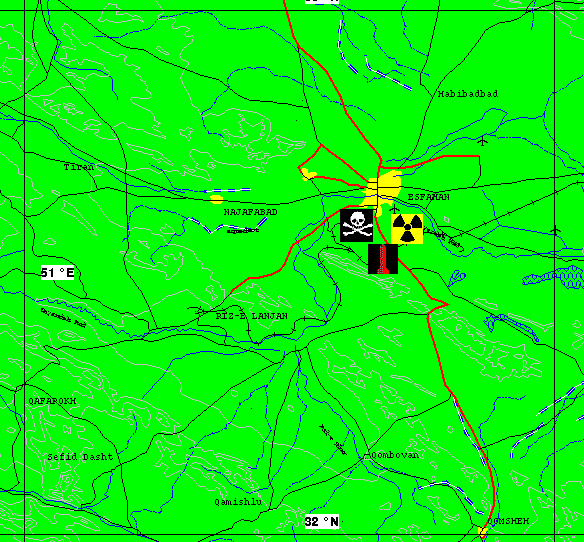

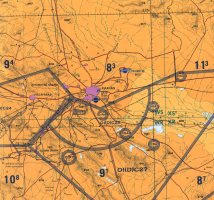
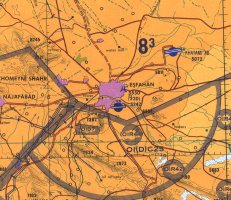
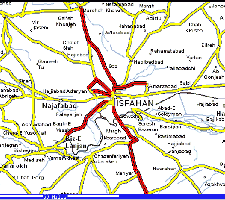
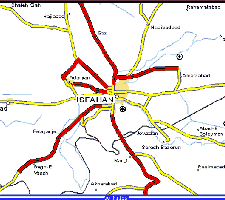
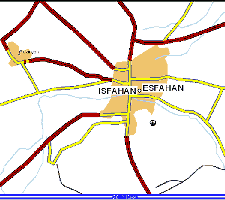
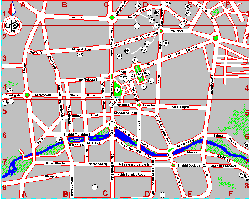
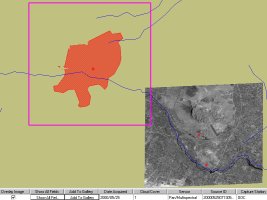



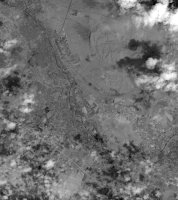
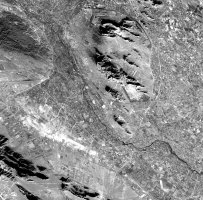
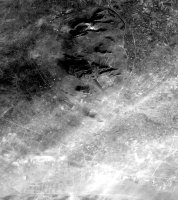
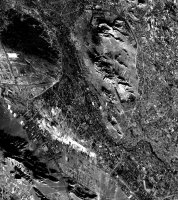
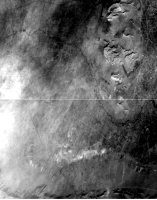
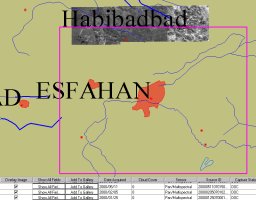
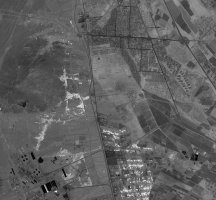
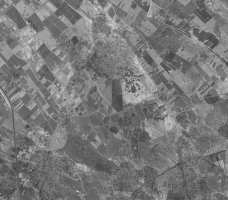
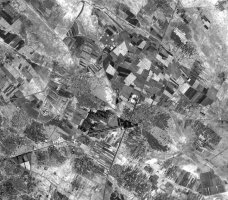
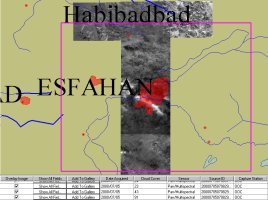
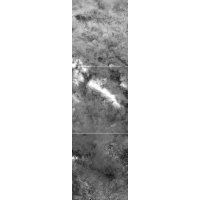
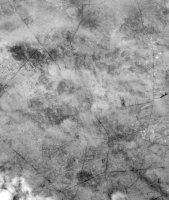
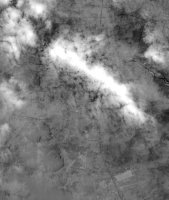
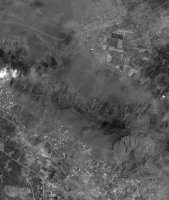
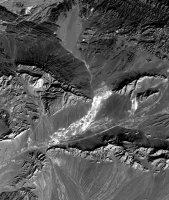
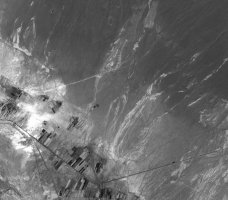
Southeast of Esfahan
Esfahan Midline strip
North of Esfahan
